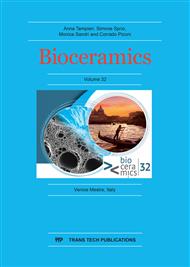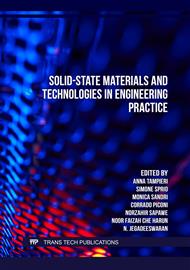p.71
p.83
p.89
p.101
p.107
p.113
p.119
p.131
p.137
New Approach to Identify the Physiological State of Bone Cells at the Surface of Hydroxyapatite Bioceramics
Abstract:
The aim of this work was to identify robust and reproducible signatures characterizing the different steps of bone cell differentiation, from precursors to mature bone cells, using approaches allowing characterization by label-free imaging. Human mesenchymal stromal cells (hMSCs) were cultured either in a growth medium (GM), unable to induce cell differentiation by itself, or in an osteogenic differentiation medium (ODM) on hydroxyapatite ceramics or borosilicate glass. Cell density as well as cell structure, size, and morphology were investigated. A fluorescence microscopy-based approach was followed, using fluorescent labelling of cell features. Some early morphological changes of hMSC during osteogenic differentiation were identified as soon as 48h that were accentuated after 7 days of culture. Cell density was higher when cells were cultured in GM and the cells exhibited significantly smaller nuclei (size ratio about 1.3-1.5) than those cultured in ODM, regardless of the culture support. In ODM, the cells were also of bigger size (1.2 to 1.5 times) and their focal adhesions were reinforcedType I collagen, a gold standard marker of osteogenic differentiation, appeared more intense in ODM. These cell features can be determined using multimodal label-free imaging methods to characterize the differentiation state of hMSCs at the biomaterial surface. They give rise to new cost-effective approaches to investigate cell behavior by suppressing the chemical markers and reducing both the number of needed samples and the requested time to do so.
Info:
Periodical:
Pages:
131-136
Citation:
Online since:
December 2022
Authors:
Price:
Сopyright:
© 2022 Trans Tech Publications Ltd. All Rights Reserved
Share:
Citation:



